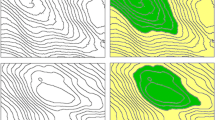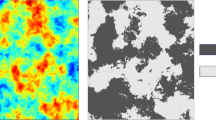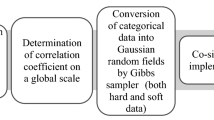Abstract
A single intrinsic stationary random field may not account for transitional heterogeneity and abrupt dissimilarity of geological properties across boundaries between rock type regions. This paper proposes the stepwise construction of transitive covariance models for modeling continuous properties correlated across boundaries of multiple disjoint physical domains such as rock type bodies. Modeling in geology is usually simplified by splitting the geological space into rock type geo-domains (e.g., strata, sedimentary facies, soil series, diagenetic regions and alteration zones). Due to the limitations of simultaneous solutions, a simplification is to model each domain independently at the cost of losing the conditioning of properties across domains. This paper proposes to organize the modeling process in a triangular array which follows events in the geological time domain; for example, the younger formations are at the top of the pyramid and the older formation at the base. The estimation may go from top to base by assuming that younger events have perturbed older formations. Geology shows the scars of events that cumulate in rock formations before they are finally eroded. In some cases, older formations may be parent material for younger formations. The continuous property within each geo-domain has a conditional covariance in the main diagonal of the array which may belong to a specific event in the geological time. This sequence leads to transitive estimation and simulations in the physical space. If a simultaneous solution is sought (i.e., the future and past are correlated both ways), the complex covariance functions can be constructed stepwise from conditional spectra.
Similar content being viewed by others
References
Bochner S (1949) Fourier transform. Princeton University Press, London, 219 p
Burrough PA, MacMillan RA, vanDeursen W (1992) Fuzzy classification method for deterministic land suitability from soil profile observations and topography. J Soil Sci 43:193–210
Carle S, Fogg GE (1996) Transition probability-based indicator geostatistics. Math Geol 28(4):453–476
Deutsch C, Wang L (1996) Hierarchical object-based stochastic modeling of fluvial reservoirs. Math Geol 28(7):857–880
Eschard R, Doligez B, Beucher H (2000) Using quantitative outcrop databases as a guide for geological reservoir modeling. In: Armstrong M, Bettini C, Champigny N, Galli A, Remacre A (eds) Geostatistics Rio 2000, vol 12. Kluwer Academic, Dordrech, pp 7–17
Goovaerts P (1997) Geostatistics for natural resources evaluation. Oxford University Press, New York, 483 p
Goulard M, Voltz M (1992) Linear coregionalization model: tools for estimation and choice of cross-variogram matrix. Math Geol 24(3):269–286
Gutjahr A, Bullard B, Hatch S (1997) General joint conditional simulation using a fast Fourier transform method. Math Geol 29(3):361–389
Hatloy A (1994) Numerical facies modeling combining deterministic and stochastic methods. In: Yarus JM, Chambers RL (eds) Stochastic modeling and geostatistics, principles, methods, and case studies. AAPG computer applications in geology, vol 3. Tulsa, Oklahoma, pp 109–120
Journel AG, Huijbregts CJ (1978) Mining geostatistics. Academic Press, New York, 600 p
Krumbein WC, Sloss LL (1963) Stratigraphy and sedimentation. Freeman, London, 660 p
Larsen G, Chilingar G (1967) Diagenesis of sediments. Elsevier, Amsterdam, 551 p
Le Ravalec M, Noetinger B, Hu LY (2000) The FFT moving average generator: an efficient numerical method for generating and conditioning Gaussian simulations. Math Geol 32:701–723
Matheron G (1973) The intrinsic random functions, and their applications. Adv Appl Probab 5:439–468
Myers DE (1982) Matrix formulation of co-kriging. Math Geol 14(3):249–257
Pardo-Iguzquiza E, Chica-Olmo M (1994) Spectral simulation of multivariable stationary random fields using covariance Fourier transforms. Math Geol 26(3):277–299
Priestley MB (1981) Spectral analysis and time series. Academic Press, New York, 890 p
Vargas-Guzmán JA (2003) Conditional components for simulation of vector random fields. Stoch Environ Res Risk Assess 17(4):260–271
Vargas-Guzmán JA (2004) Fast modeling of cross-covariances in the LMC: a tool for data integration. Stoch Environ Res Risk Assess 18(2):91–99
Vargas-Guzmán JA, Dimitrakopoulos R (2002) Conditional simulation of random fields by successive residuals. Math Geol 34(5):597–611
Vargas-Guzmán JA, Dimitrakopoulos R (2003) Successive estimation of non-parametric distributions. Math Geol 35(1):39–52
Vargas-Guzmán JA, Qassab H (2006) Spatial conditional simulation of geo-objects with application to facies modeling. J Pet Sci Eng 54:1–9
Vargas-Guzmán JA, Yeh TCJ (1999) Sequential kriging and cokriging: two powerful approaches. Stoch Environ Res Risk Assess 13(6):416–435
Vargas-Guzmán JA, Warrick AW, Myers DE (2002) Coregionalization by linear combination of non-orthogonal components. Math Geol 34(4):405–419
Wackernagel H (1998) Multivariate geostatistics. Springer, Berlin, 291 p
Webster R (1973) Automatic soil boundary location from transect data. Math Geol 5(1):27–37
Yao T, Journel A (1998) Automatic modeling of (cross) covariances tables using fast Fourier transform. Math Geol 30(6):589–615
Author information
Authors and Affiliations
Corresponding author
Rights and permissions
About this article
Cite this article
Vargas-Guzmán, J.A. Transitive Geostatistics for Stepwise Modeling Across Boundaries between Rock Regions. Math Geosci 40, 861–873 (2008). https://doi.org/10.1007/s11004-008-9166-4
Received:
Accepted:
Published:
Issue Date:
DOI: https://doi.org/10.1007/s11004-008-9166-4




